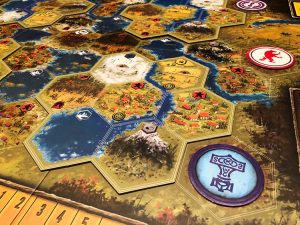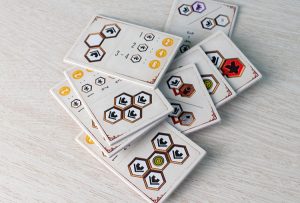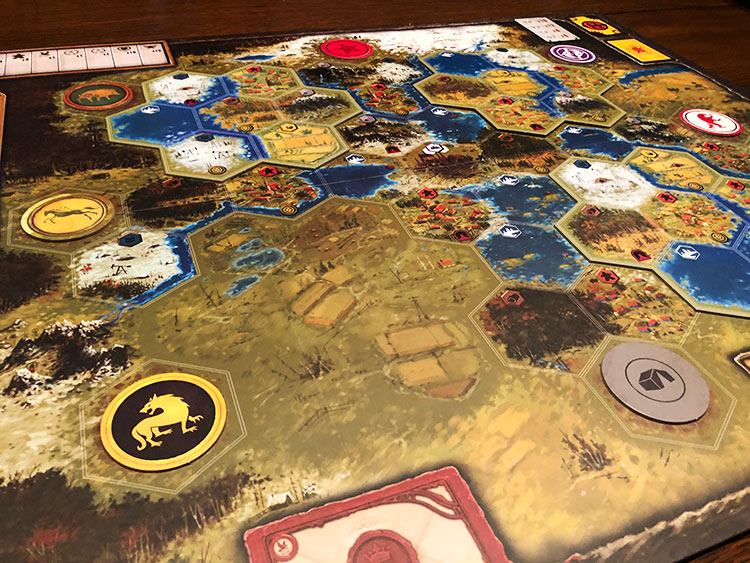 In 2016, Stonemaier Games published a much-hyped board game called Scythe. Built around the excellent artwork from Jakub Rozalski, this eurogame went out to win a pile of gaming awards. Since its release, Stonemaier has published a number of expansions including an Encounter Deck, airships in The Wind Gambit, and the excellent Rise of Fenris campaign. Today, we are going to look at the newest offering in the Scythe universe, the Modular Board.
In 2016, Stonemaier Games published a much-hyped board game called Scythe. Built around the excellent artwork from Jakub Rozalski, this eurogame went out to win a pile of gaming awards. Since its release, Stonemaier has published a number of expansions including an Encounter Deck, airships in The Wind Gambit, and the excellent Rise of Fenris campaign. Today, we are going to look at the newest offering in the Scythe universe, the Modular Board.
Expansion Overview:
The Scythe modular board is just what it sounds like. Instead of the static board that comes with the game, players now have a double-sided board (same size as the original board) with four open spots. During setup, each of these open areas is filled with one of the four modular tiles (each of which holds 7 hexes). There are a few rules for placement, such as each tile must be oriented the proper direction and no start areas can be next to a lake. If a lake is next to a river, that river becomes part of the lake.
The expansion also comes with 8 new Structure Bonus Tiles, which can be used with or without the modular board.
Game Experience with the Expansion:
The Scythe modular board is kind of a weird product to try and review. For the most part, I’d expect gamers to know what they are getting with this product. The name basically says it all. Instead of using the default game board for Scythe, you have one that changes up each time you play. So then the question that needs to be answered is do you need it? My answer to that is… maybe.
 To be honest, I feel like the game board that comes with Scythe is really good. It’s large enough for our needs, feels well balanced, and we haven’t run into any issues with it. So then, why do I need the Scythe Modular Board? To be honest, I probably don’t. But I’m also probably not the person who does (except for one large caveat I’ll touch on in a minute).
To be honest, I feel like the game board that comes with Scythe is really good. It’s large enough for our needs, feels well balanced, and we haven’t run into any issues with it. So then, why do I need the Scythe Modular Board? To be honest, I probably don’t. But I’m also probably not the person who does (except for one large caveat I’ll touch on in a minute).
The gamer that needs the Scythe Modular Board is the one that plays a LOT of Scythe. If you have every expansion, already blown through Rise of Fenris, and can pretty much sit down and play Scythe without touching the rulebook then this is the product for you. It gives some nice variety in the setup with minimal rules overhead. You will also want to be an experienced player because where you start can have a big impact on how well you do during the game since the starting resources are not necessarily as balanced as with the core board. But if you only play Scythe occasionally, or are a new player, then you’d be better off starting with one of the other expansions.

However, I did mention a caveat earlier, and that’s if you primarily play at the lower player count range. One great thing this modular board does is let you remove areas for fewer players. So if you are playing a game of Scythe with only two players, you now have the option for a much tighter game board. This could be really nice if you like confrontation as resources and areas will be more scarce.
Finally, the other great thing the expansion adds is the new structure bonus tiles. This will be a welcome addition for fans of Scythe because it adds some nice variety and replay value. As you only use one per game, you have at least 8 games of new options here.
Final Thoughts:
At the end of the day, the Scythe Modular Board is a nice addition, but probably not one everyone needs. If you are a hardcore Scythe addict, then it’s an easy buy (but you probably aren’t waiting for reviews of it anyway). The Modular Board also could be useful for those that tend to only play at lower player counts and want more interaction. For the casual Scythe player who maybe dusts off this title only every few months, you can safely give this one a pass and not feel like you are missing too much. The default game board works excellent as is.
 Hits:
Hits:
• More variety for experienced players
• More structure bonus tiles
• Tighter game at the lower player count range
Misses:
• Board won’t be as balanced as the default board























